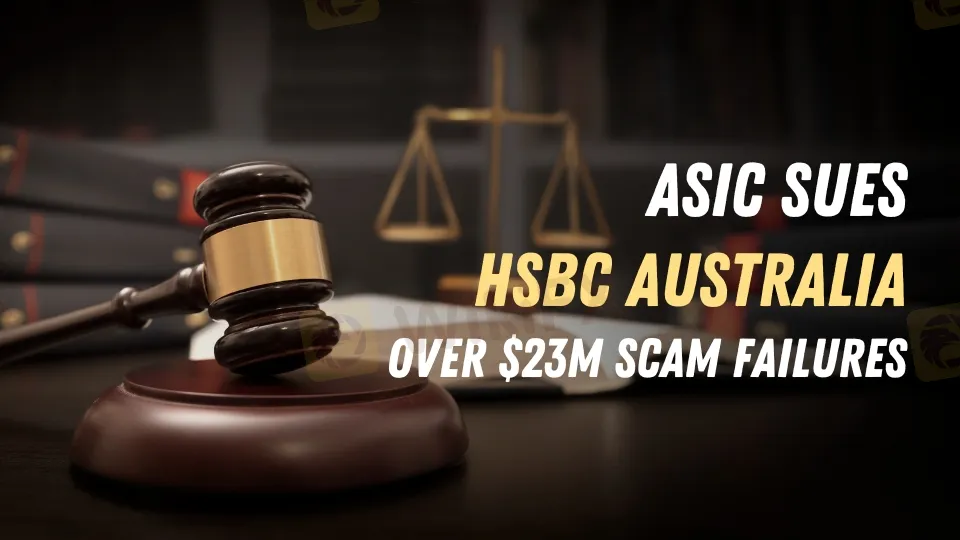简体中文
繁體中文
English
Pусский
日本語
ภาษาไทย
Tiếng Việt
Bahasa Indonesia
Español
हिन्दी
Filippiiniläinen
Français
Deutsch
Português
Türkçe
한국어
العربية
ASIC Sues HSBC Australia Over $23M Scam Failures
Abstract:ASIC sues HSBC Australia for failing to prevent, detect, and resolve $23M in unauthorized transactions, leaving scammed customers stranded for months.

The Australian Securities and Investments Commission (ASIC) has launched a lawsuit against HSBC Bank Australia Limited (HSBC Australia) for failing to appropriately safeguard clients who were duped out of millions of dollars. ASIC accuses HSBC of systematic flaws in its fraud controls and investigative systems, which left victims susceptible and resulted in lengthy delays in investigating unlawful transactions.
Key Failures Identified
ASIC found that HSBC Australia failed to:
- Implement effective fraud controls to prevent and identify unlawful payments.
- Investigate customer claims of unlawful transactions within the specified timeframe.
- Customers who have been affected should have access to financial services restored quickly.
ASIC says that these errors violated duties under Australia's Corporations Act 2001 and the National Consumer Credit Protection Act 2009.
Massive Losses to Scammers
Between January 2020 and August 2024, HSBC Australia received roughly 950 reports of fraudulent transactions, resulting in customer losses of AU$23 million. Alarmingly, approximately AU$16 million of these losses happened in only six months, from October 2023 to March 2024.

The increase in instances apparently began in mid-2023, when scammers impersonated HSBC employees to obtain access to user accounts. Despite mounting evidence, HSBC reportedly failed to create adequate mechanisms to detect or address massive fraud.
ASIC Deputy Chair Speaks Out
ASIC Deputy Chair Sarah Court emphasized the seriousness of the allegations, stating:
“We allege HSBC Australias failings were widespread and systemic, and the bank failed to protect its customers. From at least January 2023, HSBC was aware of fraud risks and gaps in their controls but did not take appropriate action. Some customers were scammed out of $90,000 or more.”
The court further criticized the bank for significant delays in resolving customer issues:
“HSBC compounded the problem by taking, on average, 145 days to investigate scam reports. Additionally, they delayed restoring customers bank account access, which took an average of 95 days. In one case, a customer waited 542 days to regain full access.”
Scammers Are Relentless
The court emphasized the critical necessity for institutions to act quickly and effectively against fraud, adding that scammers do not discriminate. People might lose their whole life savings in an instant. Banks must do more to safeguard their consumers. Where they fail, we will take legal measures to hold them responsible.
Final Thoughts
The action against HSBC Australia highlights the rising threat of scams and the essential role that financial institutions play in protecting their consumers. With fraudsters using increasingly complex strategies, banks must boost their fraud detection systems and increase reaction times. The alleged shortcomings of HSBC Australia reveal systemic flaws while also serving as a warning to the financial sector as a whole. Customers need proactive protection, and ASIC's actions demonstrate a clear commitment to holding banks accountable when they fall short.

Disclaimer:
The views in this article only represent the author's personal views, and do not constitute investment advice on this platform. This platform does not guarantee the accuracy, completeness and timeliness of the information in the article, and will not be liable for any loss caused by the use of or reliance on the information in the article.
Read more

Is FizmoFX a Scam? Fraud and Account Suspension of Traders
FizmoFX is classified as an unreliable broker according to WikiFX's assessment. Learn about the stories of traders who fell victim to fraud, where their accounts were banned, and their funds were withheld. Read this article to avoid falling into the fraud trap and protect your money.

How Arcadia Equity Co Limited Defrauded an Unemployed Woman of RM2.2 Million
An unemployed 46-year-old woman from Selangor fell victim to a sophisticated investment scam, losing a total of RM2,219,217.83. The scam involved a fake company named Arcadia Equity Co Limited, promoted through a Facebook advertisement in August 2024.

SEC Charges Nova Labs for Crypto Fraud and Violations
SEC charges Nova Labs for crypto fraud, unregistered offerings, and investor misrepresentation. Gensler's tenure ends with a bold move on crypto accountability.

eToro Files for IPO with $5 Billion Valuation on NASDAQ
eToro files for IPO on NASDAQ with a $5B valuation. Backed by Goldman Sachs, it eyes a Q2 2025 listing. Learn about its social trading platform and rivals.
WikiFX Broker
Latest News
Will Gold Prices Continue to Rise Due to Trump’s Tariffs?
Miami Firm Owner Pleads Guilty to $6M Ponzi Scheme Fraud
NBI Cebu Arrests Forex Trader for Illegal Investment Solicitation
PU Prime's "Feather Your Trades" Contest! Begin
eToro Files for IPO with $5 Billion Valuation on NASDAQ
Is FizmoFX a Scam? Fraud and Account Suspension of Traders
Why the Federal Reserve Is So Important
Boerse Stuttgart Digital Secures EU-Wide MiCAR Crypto License
BOJ to Announce Policy Decision This Week, Market Bets on a Rate Hike
Crypto.com’s Dual Front Battle: European Progress and U.S. Regulation
Currency Calculator






